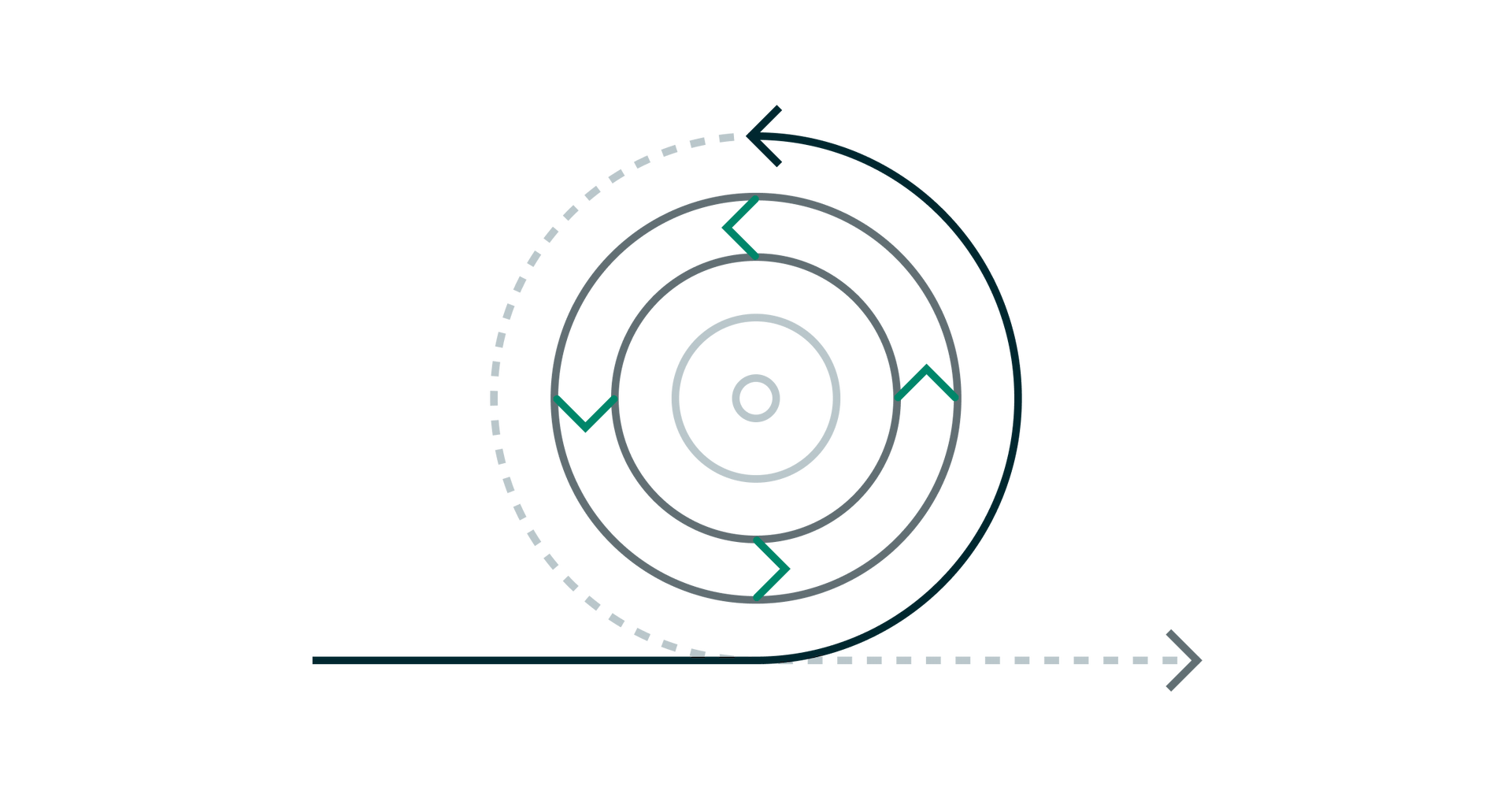Quantive is now part of WorkBoard. Get to know WorkBoard:
Agile methodology definition
Key takeaway: The overaching Agile methodology helps product and project managers alike create customer-centric, value-focused process. Collaboration and feedback are core elements of any successful Agile methodology, driving a responsive, efficient approach to management.
For a quick overview of the Agile methodology definition: Agile is a project management philosophy, originally created to collaborate on and iterate the software development process.
Its emphasis on customer-centric improvements and reducing time to value makes it a popular methodology for teams focused on short-term development cycles.
The Agile methodology can seem overwhelming at first. But above all else, Agile is a mindset, informed by a well-documented set of values, phases, and principles.
It’s easy to get caught up in these technicalities and fine details of Agile. To understand what the agile methodology is, let’s take it one step at time, beginning with the Agile Manifesto.
The Agile manifesto and Agile history
In 2001, 17 software developers — including Kent Beck, Ron Jeffries, Ken Schwaber, Martin Fowler, and Jeff Sutherland — formally wrote the Agile Manifesto.
The Agile Manifesto outlines 12 principles for the Agile framework:
- Satisfy customers through continuous, early delivery of valuable software
- Flexibly change requirements, even in late development
- Deliver working software frequently
- Open collaboration between businesspeople and developers
- Build projects around motivated and trusted individuals
- Face-to-face communication is most effective
- Working software is the main measure of progress
- Sponsors, developers, and users should maintain a constant pace
- Continuous attention to technical excellence and good design
- Simplicity — maximizing just the right amount of work — is essential
- Autonomy delivers the best architectures, requirements, and designs
- The team regularly reflects and adjusts to be more effective
These inform the values and phases of Agile and its sub-frameworks. The Agile Manifesto kicked off the development and iteration of the Agile process, which has progressed over three distinct waves.

Wave 1: Agile development teams in the early 2000s
The first proper wave of Agile management began when the Agile Manifesto was published in 2001. Agile methodologies — namely Extreme Programming (XP) and Scrum — were used to streamline software development and improve project management. These capabilities grew in importance as enterprise digitalization and software-driven processes became prominent.
Wave 2: Agile across business functions in the 2010s
By 2010, the second wave of Agile management was making its rounds in more traditional organizations. It involved vast, distributed functions leveraging the Agile framework in a coordinated, scalable fashion to overcome issues prevalent in big enterprises.
This functional wave propelled the rapid adoption of Agile practices, with Agile qualifications ensuring efficient deployment across functions. These formal accreditations attracted innovative leaders from every part of the organization, paving the way for the third wave of Agile.
Wave 3: Business-wide Agile adoption in the modern era
The third wave of Agile management that we're currently in involves enterprise-wide Agile adoption. By scaling Agile across the entire organization, companies sought to cultivate a culture of experimentation and rapid learning cycles.
This scaled adoption was further accelerated when organizations embraced the inevitability of volatility, uncertainty, complexity, and ambiguity (VUCA). This led companies to shift from traditional silos to value-generating activities. For this to work, stakeholders must be entirely bought in, ensuring agility drives company operations.
Now let's explore the core values of Agile in more detail to understand how the Agile lifecycle is created.
The 4 values of Agile
The values of Agile are derived from the Agile Manifesto. To keep the themes simple, the Agile methodology is about questioning traditional processes and focusing on what actually drives value for the business. The four values of Agile are:
- Individuals and interactions over processes and tools
- Working software over comprehensive documentation
- Customer collaboration over contract negotiation
- Responding to change over following a plan

1. Individuals and interactions over processes and tools
People drive project development — they are in tune with the process and needs of the business. Process for the sake of process isn’t effective or lean, and people should question if processes or tools are necessary.
2. Working software over comprehensive documentation
Creating an Agile environment isn’t about eliminating documentation altogether, but streamlining it. If it’s not necessary for the project or doesn’t create value for the customer, it’s unnecessary.
3. Customer collaboration over contract negotiation
Meeting the needs of the customer means involving them in the process, rather than rigidly developing a product without feedback or insight.
4. Responding to change over following a plan
Whether shipping a product or project, adaptability and strategic agility are key. For end value, flexible and iterative development exceeds rigid and siloed development.
These four values of the Agile framework serve as a blueprint for the five phases of the Agile lifecycle.
The Agile process: 5 phases of the Agile lifecycle
The Agile process is a continuous feedback loop, driven by the concepts of ideation, creation, and iteration. Its five phases work together to create sprints for your project or product:
- Define: Team defines the scope, objectives, and priorities of the project
- Design: Team members, tools, and resources ensure optimal production
- Iteration: Team positions product changes based on priorities and requirements
- Release: Teams test, finalize, and deploy product into production
- Review and monitor: Teams look at performance and solicit feedback from stakeholders to update the next sprint’s backlog

Again, Agile is less of a methodology and more of an overarching mindset. Numerous frameworks have been created under its umbrella to adapt Agile to specific project types, teams, and other parameters.
We’ll look at some examples to better understand the flexibility of Agile methodology.
Examples of Agile methodologies
While the following Agile methodologies are the most popular, they are just a few examples of sub-Agile methodologies. Succeeding with any Agile method is about understanding the goals of your team and the strategy you’re trying to execute first.

Lean Agile
Lean Agile combines lean and Agile management principles, removing waste while ensuring continuous product improvement. This helps organizations maximize value by eliminating activities and tasks that are ineffective, wasteful, or futile.
Kanban
Kanban visually depicts the Agile methodology to make completing tasks more effective. This is done using a collective Kanban board that segments sequential tasks under “To do,” “Doing,” and “Done” — this transparency helps teams understand which parts of the projects are stuck or moving forward.
SAFe Agile
SAFe Agile (aka Scaled Agile Framework) focuses on implementing Agile principles at an enterprise scale, where the accommodation and coordination of large numbers of teams is a priority.
Scrum
Adaptability and reprioritization are the basis of the Scrum framework. In Scrum teams, continuous cross functional collaboration is emphasized through sprints, with solidified roles, responsibilities, and meeting cadences.
Other examples of Agile frameworks include:
Crystal
Crystal is an all-inclusive term for group-size based project rules and procedures, from Crystal clear (1-6 people) to Crystal diamond (200+ people). Crystal Agile takes frequent delivery and collaboration and emphasizes personal safety during idea expression.
Extreme Programming (XP)
Best applied in engineering space, extreme programming also puts emphasis on work quality and shared workspaces for open collaboration.
Lean Startup
This Agile framework overlays lean manufacturing principles with the process of developing new products. Its goal is to validate assumptions and try ideas before pouring in more resources.
Benefits of Agile management
While the execution of any Agile methodology will determine the extent of its benefits, the benefits of Agile are extensive and specific:
- Solutions are implemented quicker due to team flexibility
- Waste is reduced as resources are used more efficiently
- Workflows and process are adaptable because change is expected
- The process is flexible, allowing for adjustments as needed
- Clarity on progress comes from built-in transparency
- Delivery times are shorter, due to iterative development cycles
- Issues and defects are addressed quickly because of regular review processes
- Efficiency is optimized because delivering consistent value is the focal point
- Management is lightweight and easy because bureaucratic silos are discouraged
- Projects can hit tighter deadlines with regular checkpoints and reviews
- Customer satisfaction is high because feedback loops are ingrained
- Products quality is improved due to regular testing and quality checks
- Collaboration is fostered with regular team communication around sprints
Challenges of the Agile method
Despite its extensive benefits, the Agile method (just like any other methodology) comes with its unique set of challenges:
- Change management is a concern with engrained systems and processes
- Lack of structure can impact output consistency without guidance
- Project overcommitment can lead to burnout, especially with limited resources
- Communication friction can inhibit productivity in distributed teams
- Process can be bottlenecked by external dependencies
- Agile transformation, at scale, is complex for any size organization
How to use Agile in your day-to-day
Agile’s ability to shorten delivery cycles, foster collaboration, and drive a process focused on rapid iteration makes it an ideal philosophy in the Modern Operating Model.
When combined with a goal setting methodology like OKRs, Agile can provide a purpose-driven, streamlined, and efficient way to reach your company’s goals. Check out the read next article to learn more about using OKRs to put the Agile method into action.
Quantive empowers modern organizations to turn their ambitions into reality through strategic agility. It's where strategy, teams, and data come together to drive effective decision-making, streamline execution, and maximize performance.
As your company navigates today’s competitive landscape, you need an Always-On Strategy to continuously bridge the gap between current and desired business outcomes. Quantive brings together the technology, expertise, and passion to transform your strategy and playbooks from a static formulation to a feedback-driven engine for growth.
Whether you’re a fast-growing scale-up, a mid-market business looking to conquer, or a large enterprise looking for innovation, Quantive keeps you ahead – every step of the way. For more information, visit www.quantive.com.





